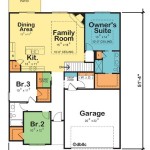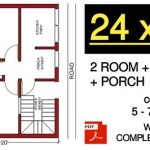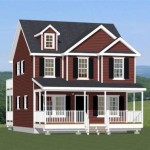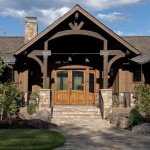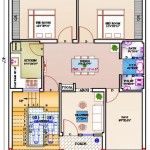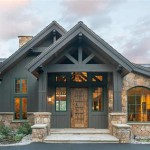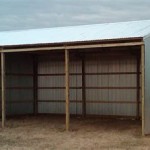Small Barndominium Floor Plans With RV Garage: Maximizing Space and Functionality
The barndominium, a blend of barn and condominium, has gained considerable popularity as a housing alternative, offering open-concept living with a rustic aesthetic. A growing subset of this trend involves incorporating an RV garage into the barndominium design, providing convenient storage and maintenance space for recreational vehicles. Small barndominium floor plans featuring RV garages present a unique challenge: effectively balancing living space, garage dimensions, and overall property footprint. This article explores the considerations and design strategies involved in creating efficient and functional small barndominium floor plans with integrated RV garages.
Designing a small barndominium with an RV garage necessitates a careful evaluation of needs and priorities. The dimensions of the RV, desired living space, and budget limitations all play crucial roles in shaping the final floor plan. The goal is to create a harmonious balance that avoids sacrificing functionality in either the living area or the garage space.
Key Considerations for Small Barndominium Design
Several key factors influence the design process for these types of structures. These considerations involve structural integrity, zoning regulations, and the precise needs of the homeowner.
Structural Integrity and Building Codes: The inclusion of a large RV garage necessitates careful attention to structural support. The clear span required for RV access often demands significant engineering to ensure the building's stability. Steel framing is a common choice for barndominiums, offering the necessary strength and durability, particularly for larger spans. Local building codes dictate specific requirements for foundation, framing, insulation, and fire safety. Engaging a qualified structural engineer is essential to ensure the design meets all applicable codes and safety standards. The engineer will consider load-bearing walls, roof pitch, and wind and seismic loads when determining the appropriate structural components.
Zoning Regulations and Permits: Before embarking on a barndominium project, researching local zoning regulations is paramount. Many jurisdictions have specific rules regarding building types, setbacks, height restrictions, and allowable uses for agricultural or residential land. Some areas may have restrictions on the size or appearance of accessory structures like RV garages. Obtaining the necessary permits is a crucial step to avoid potential fines or legal issues down the line. Permitting processes typically involve submitting detailed floor plans, elevation drawings, and structural calculations for review and approval by local authorities.
RV Garage Dimensions and Accessibility: The dimensions of the RV itself are the most critical factor in determining the garage size. Consider the height, length, and width of the RV, as well as any anticipated future upgrades to larger models. Adequate clearance is essential for maneuvering the RV in and out of the garage. A minimum door height of 14 feet is generally recommended for most RVs, although larger models may require taller doors. The garage depth should accommodate the RV's length plus additional space for walking around and performing maintenance. The width should allow for easy access to both sides of the RV. The positioning of the garage door in relation to the driveway or access road is also important for ease of entry and exit. Turning radius and available space should be considered.
Floor Plan Strategies for Maximizing Space
Smart design is crucial for optimizing the use of space in a small barndominium with an RV garage. Several strategies can be employed to create a functional and comfortable living environment without sacrificing garage space.
Open-Concept Living: Open-concept floor plans are ideal for small barndominiums, as they create a sense of spaciousness and allow for flexible use of the living area. Combining the living room, dining area, and kitchen into a single, flowing space eliminates the need for interior walls, maximizing natural light and creating a more inviting atmosphere. The layout can be further enhanced by incorporating large windows and high ceilings to create a sense of vertical space.
Strategic Placement of Bedrooms and Bathrooms: Careful placement of bedrooms and bathrooms is essential to maximize privacy and functionality. Positioning these spaces along the perimeter of the barndominium can help create distinct living zones. Ensuite bathrooms connected to the master bedroom offer added convenience and privacy. Utilizing space-saving fixtures, such as wall-mounted toilets and compact sinks, can help conserve space in smaller bathrooms.
Loft Spaces and Vertical Integration: Incorporating a loft space can add valuable square footage without increasing the building's footprint. Lofts can be used as bedrooms, offices, or recreational areas. Vertical integration can also be achieved through the use of high ceilings, which can accommodate storage lofts or mezzanine levels. These elevated spaces can be accessed by stairs or ladders, providing additional storage or living space.
Utilizing Garage Space Efficiently: The RV garage can serve more than just RV storage. Consider incorporating a workbench area for repairs and maintenance. Adding storage cabinets or shelving along the walls can help organize tools and equipment. The garage can also be used as a workshop or hobby area, provided that adequate lighting and ventilation are installed.
Design Elements and Features
Beyond the floor plan, specific design elements and features can enhance the functionality and aesthetic appeal of a small barndominium with an RV garage.
Insulation and Climate Control: Proper insulation is critical for energy efficiency and comfort. Spray foam insulation is a popular choice for barndominiums, as it provides excellent thermal performance and helps seal air leaks. Efficient HVAC systems are also essential for maintaining a comfortable indoor climate, especially in areas with extreme temperatures. Consider using a zoned system to control temperatures in different areas of the barndominium independently.
Natural Light and Ventilation: Maximizing natural light can make a small barndominium feel more spacious and inviting. Incorporate large windows and skylights to bring in natural light. Proper ventilation is also important for maintaining air quality and preventing moisture buildup. Install windows that can be opened for cross-ventilation. Consider adding a whole-house ventilation system to circulate fresh air.
Material Selection and Aesthetics: The choice of materials can significantly impact the overall aesthetic of the barndominium. Steel siding and roofing are commonly used for their durability and low maintenance. Interior finishes can be chosen to complement the rustic aesthetic, such as wood floors, exposed beams, and stone accents. Consider using reclaimed materials to add character and reduce environmental impact.
Accessibility Considerations: When designing a barndominium, it's important to consider accessibility for people with disabilities. Wider doorways, ramps, and accessible bathrooms can make the home more inclusive and accommodating. These features can also be beneficial for aging in place.

Plan 280185jwd Modern Barndominium Style House With Rv Garage 1273 Sq Ft 1673

Mesquite Double Rv Garage Model House Plans Barndominium Floor Barn Homes

Rv Garage Plans With Incredible Storage Blog Dreamhomesource Com

Barndominium Style Carriage House W Rv Garage Sand Springs

50x48 1 Rv Garage Br 5 Ba Floor Plan 2 274 Sq Ft Instant Model 5b

Rv Garage Plans With Incredible Storage Blog Dreamhomesource Com

Storage Solutions Rv Garage Plans And More Houseplans Blog Com

I Really Like This Plan Somehow It Needs A Door From The Closet To Laundry Room

Rv Garage Plans With Living Quarters Houseplans Blog Com

Classy 4bhk Barndominium W Rv Parking Space 6 Car Garage Hq Plans 3d Concepts

